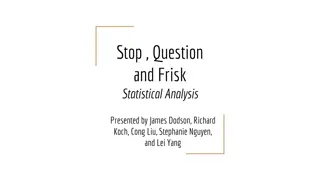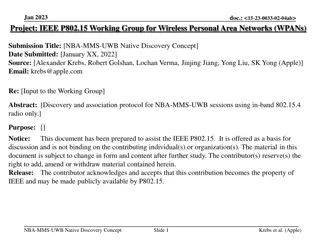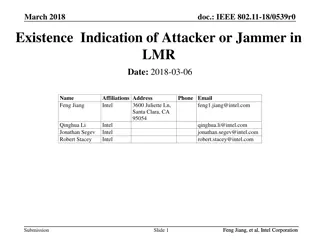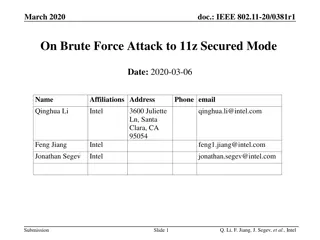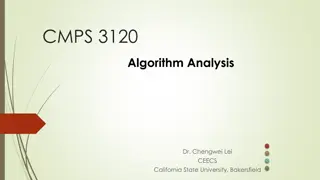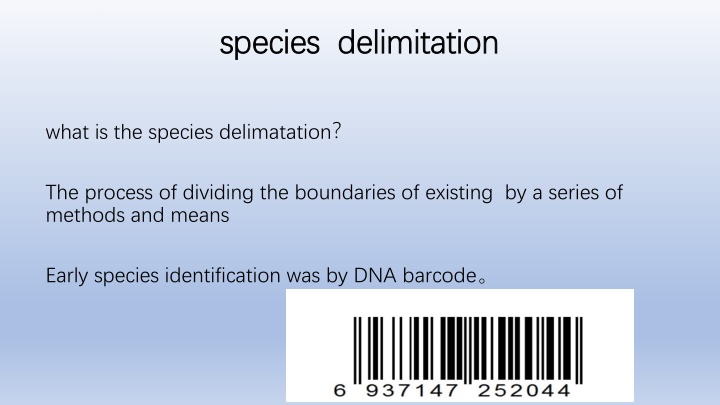
Species Delimitation Methods: BFD and Model Comparison
Learn about species delimitation techniques such as Bayesian Factor Delimitation (BFD) and model comparison, including the advantages of BFD, integration of species trees, and the analysis requirements. Explore the process of dividing species boundaries using DNA barcoding and SNP data, supported by programs like BEAST and SNAPP.
Download Presentation

Please find below an Image/Link to download the presentation.
The content on the website is provided AS IS for your information and personal use only. It may not be sold, licensed, or shared on other websites without obtaining consent from the author. If you encounter any issues during the download, it is possible that the publisher has removed the file from their server.
You are allowed to download the files provided on this website for personal or commercial use, subject to the condition that they are used lawfully. All files are the property of their respective owners.
The content on the website is provided AS IS for your information and personal use only. It may not be sold, licensed, or shared on other websites without obtaining consent from the author.
E N D
Presentation Transcript
species delimitation species delimitation what is the species delimatation The process of dividing the boundaries of existing by a series of methods and means Early species identification was by DNA barcode LMSE
BFD(Bayes factor delimitation) A method of species delimitation in a Bayesian framework using SNP data and the programs SNAPP and BEAST. Bayes factor: MLE( marginal likelihood estimate ) value LMSE
The advantage of BFD One advantage of BFD over other species ,delimitation approaches is the ability to integrate over species trees during the species delimitation procedure, which removes the constraint of specifying a guide tree that represents the true species relationships. Another advantage is the ability to compare models that contain different numbers of species disadvantage the user needs to predefine the number of species and sample assignments, and this prevents the method from searching among all possible species assignments. LMSE
model three sample modle1 A B modle1 A B modle2 A C B D modle2 A C B D modle3 A BC D modle3 A BC D modle4 ABC D modle4 ABC D modle5 modle5 A B C D A B C D C D C D LMSE
modle BF=2*(MLE1 BF=2*(MLE1- -MLE2) A negative BF value indicates support in favor of model1. A negative BF value indicates support in favor of model1. A positive BF value indicates support in favor of model 2. A positive BF value indicates support in favor of model 2. 0 < ln(BF) < 1 is not worth more than bare mention (1<BF<2.7) 0 < ln(BF) < 1 is not worth more than bare mention (1<BF<2.7) 1 < ln(BF) < 3 is positive evidence(2.7<BF<20) 1 < ln(BF) < 3 is positive evidence(2.7<BF<20) 3< ln(BF) < 5 is strong support(20<BF<148) 3< ln(BF) < 5 is strong support(20<BF<148) 5< ln(BF) is decisive(148<BF) 5< ln(BF) is decisive(148<BF) MLE2) LMSE
What do we need in BFD analysis? 1.programs:We will be using the free, open-source software package, BEAST (Bayesian Evolutionary Analysis Sampling Trees; http://beast2.org), for estimating species trees. For this tutorial, you will need to use BEAST version 2.1 or better. The distribution comes with the BEAUTi, including SNAPP. 2.data: the data should be in binary format(necessary for SNAPP) LMSE
THANK YOU LMSE



